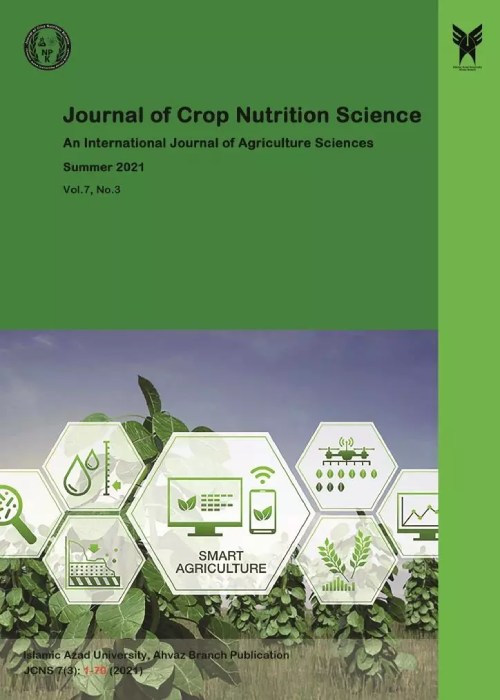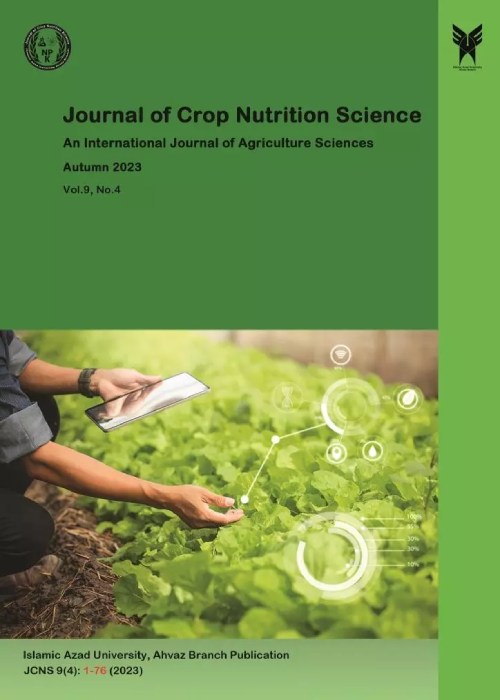فهرست مطالب

Journal of Crop Nutrition Science
Volume:7 Issue: 3, Summer 2021
- تاریخ انتشار: 1400/07/08
- تعداد عناوین: 6
-
Pages 1-10BACKGROUNDManagement of nutrients, especially nitrogen, in order to wheat economic production and maintain sustainable agriculture and to provide food security, is considered to have an important priority.OBJECTIVESCurrent study was done to assess effect of different rate of combination fertilizer and biological fertilizer and type of application biofertilizer on morphological and qualitative characteristics of Wheat.METHODSThis research was carried out via factorial experiment based on randomized complete blocks design with three replications along 2020-2021 year. The treatments included different rate of combination Nitrogen fertilizer and Biofertilizer (Fla Wheat) (a1: 100% nitrogen with nonuse of Fla Wheat as control or N100/F0, a2: 70% Nitrogen with Fla Wheat or N70/F1, a3: 40% Nitrogen with Fla Wheat or N40/F1) and several methods of applying biofertilizer (Fla Wheat) (b1: 100% Seed treatment, b2: 100% by irrigation, b3: 50% seed treatment with 50% by irrigation).RESULTResult of analysis of variance indicated effect of different level of fertilizer combination, method of application fertilizer (instead spike length) and interaction effect of treatments (instead spike length, seed nitrogen content and seed protein content) on all measured traits was significant. Mean comparison result of different level of fertilizer combination showed that maximum amount of plant height (84.71 cm), spike length (11.68 cm), seed yield (7032.1 kg.ha-1) and seed nitrogen content (2.13%) was noted for N100/F0 and minimum of those belonged to N40/F2 treatment. As for Duncan classification made with respect to different level of Method of application fertilizer the highest and lowest amount of measured traits was for M3 and M2 treatment (instead spike length and seed protein content). Seed protein content against treatment showed reverse trend.CONCLUSIONBased on result of current research according economically situation consume 70% Nitrogen with biofertilizer (Fla Wheat) at 50% seed treatment with 50% by irrigation can advised to producers.Keywords: Nitrogen, Plant height, Protein, Spike length, Yield
-
Pages 11-23BACKGROUNDDrought stress limits the growth and development of plants. The use of Humic acid (HA) is one of the topics commonly addressed by researchers to study the physiological efficiency and yield of crops under drought stress.OBJECTIVESBased on this, a study was conducted to investigate drought stress and different levels of HA on the performance characteristics of quinoa.METHODSCurrent research was conducted as a randomized complete block statistical design in the form of split plots with three replications. Treatments include main plots with three levels of drought stress including 60% evaporation from class A evaporation pan or non-application of drought stress, 90% evaporation from class A evaporation pan or medium stress and 120% evaporation from class A evaporation pan or severe stress and four levels of HA included non-consumption and doses of 50, 100, 150 mg.l-1 in the subplot.RESULTThe results showed that in the treatment without drought stress and consumption of 100 mg.l-1 HA, the highest biological yield of 6508 kg.ha-1 was obtained. The lowest rate was obtained in the treatment of severe drought stress and non-use of HA at the rate of 3068.6 kg.ha-1. Moreover, according to results, in the treatment without drought stress and consumption of 100 mg.l-1 HA, the highest grain yield was obtained at 2105.4 kg.ha-1 and the lowest obtained in the treatment of severe drought stress and no consumption of HA (999 kg.ha-1). Under drought stress, the application of HA fertilizer reduces the effect of drought stress on the growth processes of quinoa. In this study, it was found that the performance of quinoa at 100 mg.l-1 HA showed a better response than other levels of HA. Considering the improvement of quinoa yield components by optimally increasing HA and obtaining more grain yield, the results indicate the appropriate response of quinoa to HA.CONCLUSIONIn general, the results show that drought stress had a significant effect on growth characteristics, quinoa yield. Considering the improvement of quinoa yield components by optimally increasing HA and obtaining more grain yield, the results indicate the appropriate response of quinoa to HA.Keywords: Biological yield, grain nitrogen, harvest index, Protein yield, Quinoa
-
Pages 24-33BACKGROUNDNutrients play a very important role in chemical, biochemical, physiological, metabolic, geochemical, biogeochemical, and enzymatic processes.OBJECTIVESThis research was done to assess the effect of different concentration and stage of foliar application of Copper on seed yield, yield components and harvest index of Cowpea.METHODSThis research was carried out via factorial experiment based on randomized complete blocks design with three replications along 2017 year. The treatments included different concentration of Copper foliar application (a1: none use of copper or control, a2: 150 gr.ha-1, a3: 300 gr.ha-1, a4: 450 gr.ha-1) and Copper foliar application at different growth stage (b1: apply at vegetative stage, b2: beginning of flowering stage, b3: beginning of pod formation). This experiment had 36 plots.RESULTResult of analysis of variance revealed effect of different concentration and growth stage of foliar application of Copper on all measured traits was significant but interaction effect of treatments was not significant (instead number of pod per plant, seed yield and biologic yield). Mean comparison result of different concentration of foliar application of Copper indicated that maximum amount of number of pod per plant (14.83), number of seed per pod (11.96), seed weight (23.65 gr), seed yield (211.61 gr.m-2), biologic yield (509.19 gr.m-2), harvest index (41.55%) was noted for 300 gr.ha-1 Copper (Also it doesn’t have significant difference with 150 gr.ha-1 Copper) and minimum of those belonged to control treatment. As for Duncan classification made with respect to different growth stage of foliar application of Copper the highest amount of number of pod per plant (14.18), number of seed per pod (12.04), seed weight (23.41 gr), seed yield (206.01 gr.m-2), biologic yield (518.75 gr.m-2), harvest index (40.75%) belonged to vegetative stage and lowest ones was for beginning of pod formation.CONCLUSIONFinally based on result of current research according economic aspects use of 150 gr.ha-1 of copper foliar application in the vegetative stage at studied region is advised to producers.Keywords: Crop production, harvest index, Nutrition, POD, Pulse
-
Pages 34-45BACKGROUNDGreen basil is a nutritional and medicinal plant due to its valuable properties. Improving qualitative and quantitative traits of plants with appropriate methods in sustainable agricultural were emphases. Biostimulants derived from organic materials and stimulate natural process in plants and improve crop performance.OBJECTIVESIn this research the effects of some biostimulants (amino acids, humic acid and seaweed extract) on morpho-physiological properties of green basil were evaluated.METHODSThis research was carried out under greenhouse condition. The experiment was conducted based on Completely Randomized Design with ten treatments and three replications. The treatments included control (distilled water), seaweed extract (0.5, 1 and 2 gr.l-1), amino acid (1, 2 and 3 gr.l-1) and humic acid (1, 2 and 3 ml.l-1).RESULTThe results showed that application of different biostimulants positive effects on vegetative parameters and biochemical properties of green basil plants. The highest leaf numbers (21.67) was measured in amino acid application at 1 g.l-1 concentration. The effect of humic acid was more noticeable on increased plant height (37.00- 47.67 cm) in compare to other biostimulants. The plants that received biostimulants had higher plant fresh weight than control treatment. Seaweed extract and humic acids increased significantly carotenoid content of plants. The highest ascorbic acid content was measured in treated plants at levels of 2 and 3 gr.l-1 amino acid. Application of all biostimulants were used in this study, had positive effects on concentration of total phenolic content of basil plants.CONCLUSIONAccording to the results of the present study, it can be concluded that, application of biostimulants at proper concentration due to positive effect on quality and quantity of growth parameters and biochemical properties of green basil plants are recommended.Keywords: Leaf area, Plant height, Carotenoid, Ascorbic acid, Total phenolic content
-
Pages 46-58BACKGROUNDKnowing about seed yield and its components plays an important role for being successful in evaluative programs. For optimization of crop production, sowing at the appropriate time to fit the cultivar maturity length and growing season is critical.OBJECTIVESCurrent study was done to assess the effect of different planting date and density on seed yield, its components and harvest index of breed Wheat.METHODSThis research was carried out via split plot experiment based on randomized complete blocks design with three replications. The treatments included four planting dates (November 6th and 21st, December 6th and 21st) and different density (300, 400, 500, 600 and 700 seed per square meter).RESULTAccording result of analysis of variance effect of planting date, density and interaction effect of treatments on all measured traits (instead number of seed per spikelet) was significant. Delay in planting caused the number of spikes per m2, number of seeds per spike, 1000-seed weight and seed yield from 493.3 spikes, 46.2 seeds, 32.2 grams and 6964 kg.ha-1 on the planting date of 30 November to 493.3 spikes, 40 seeds, 28.5 grams, 4831.6 kg.ha-1 should be reduced on 30 December. Assessment mean comparison result of interaction effect of treatments indicated maximum seed yield (7298.7 kg.ha-1) was noted for 6 Nov. and 500 plant per m2 and lowest one (4235.2 kg.ha-1) belonged to 6 Dec. and 700 plant per m2 treatment.CONCLUSIONGenerally based on result of current research planting date in domain sixth until twenty-first of November with density of 500 plants per m2 had the highest crop production and it can advise to farmers under studied region.Keywords: Biomass, Phenology, Seed, Spike, Yield
-
Response of Qualitative Characteristics of Cowpea to Foliar Application of Methanol and Zinc ChelatePages 59-70BACKGROUNDFoliar fertilization has the advantage of low application rates, uniform distribution of fertilizer materials and quick responses to applied nutrients. Zinc Playing an important role in many biological processes and as an essential element for plant growth and development.OBJECTIVESThis study was done to evaluate the effect of different level of Methanol and Zinc fertilizer on chlorophyll index, protein content, leaf area index and crop production.METHODSThis study was carried out according Factorial experiment based on randomized complete blocks design with three replications along 2018 year. The test factors consisted of different levels of Methanol in distilled water at three levels (a1: the absence of methanol or control, a2: 10% Vol., a3: 20% Vol.) and zinc fertilizer (b1: the lack of zinc or control, b2: 2 per thousand, b3: 4 per thousand).RESULTData of analysis of variance indicated effect of different level of Methanol and zinc fertilizer on all studied traits were significant but interaction effect of treatments (instead seed yield) was not significant. Mean comparison result of different level of Methanol indicated that maximum amount of plant height (153.49 cm), pod length (13.12 cm), leaf area index (4.43), chlorophyll index (58.33), protein content (31.51%), protein yield (68.71 gr.m-2) and seed yield (218.08 gr.m-2) was noted for 20%vol. and the minimum of mentioned traits were for control treatment. As for Duncan classification made with respect to different level of Zinc Chelate maximum and minimum amount of studied traits belonged to 4 per thousand concentration (also that doesn’t have significant differences with 2 per thousand) and control treatment.CONCLUSIONGenerally based on result of this study use 20%vol. Methanol and 2 per thousand concentration Zinc Chelate produce the maximum amount of mentioned characteristics and can be advice to farmers.Keywords: Chlorophyll, leaf area index, Plant height, Pod length, Protein


